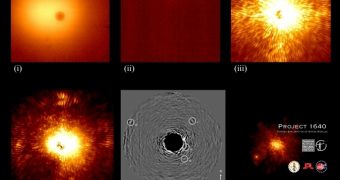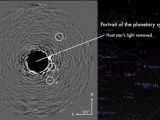There are several ways astronomers discover and study exoplanets, each with their advantages and disadvantages. The Kepler space observatory, for example, looks at a patch of the sky containing some 150,000 stars and detects minute changes in brightness, which indicate a planet passing in front of the star.
This is great for finding a lot of exoplanets fast, something Kepler clearly managed to do, but it doesn't tell us much about the planets themselves apart from their size and orbits.
Project 1640 takes another approach; a team of astronomers is using several instruments to directly observe exoplanets, i.e. "see" them, while simultaneously gathering information about their chemical composition.
They've used this method to study the makeup of a relatively close system, HR 8799. Previously, only the outermost exoplanet of the system had been observed.
The astronomers looked at the chemical makeup of the four exoplanets. They were able to not only see the planets around the star, but also discover quite a few things about the conditions on those planets.
What they found was rather surprising; all four planets have a chemical makeup unlike anything astronomers ever saw or expected, and all four are different from each other.
What's more, they were able to gather all of this for all four worlds at once in only one hour of observations.
The planets are all relatively young, between 30 to 100 million years old, and are still warm from their creation, at about 1,000 degrees Kelvin (1,340 degrees Fahrenheit).
Astronomers used the Hale Telescope in California to both observe the planets, by obscuring the light from the much brighter star, and study their makeup with spectroscopy.
Seeing the planets alone is a major achievement; HR 8799 is 1.6 times bigger than the sun but 5 times as bright. Its brightness also varies wildly, by as much as eight percent over two days. It also produces about 1,000 times more ultraviolet light.
All of this combines to create some strange conditions on the four planets, all of which are much larger than anything in the solar system, with 5 to 13 times the mass of Jupiter.
Using this technique, astronomers should be able to both discover exoplanets fast, and also study the makeup of their atmosphere, which in turn should provide them with an idea of whether the planets can harbor life or not.

 14 DAY TRIAL //
14 DAY TRIAL // 

